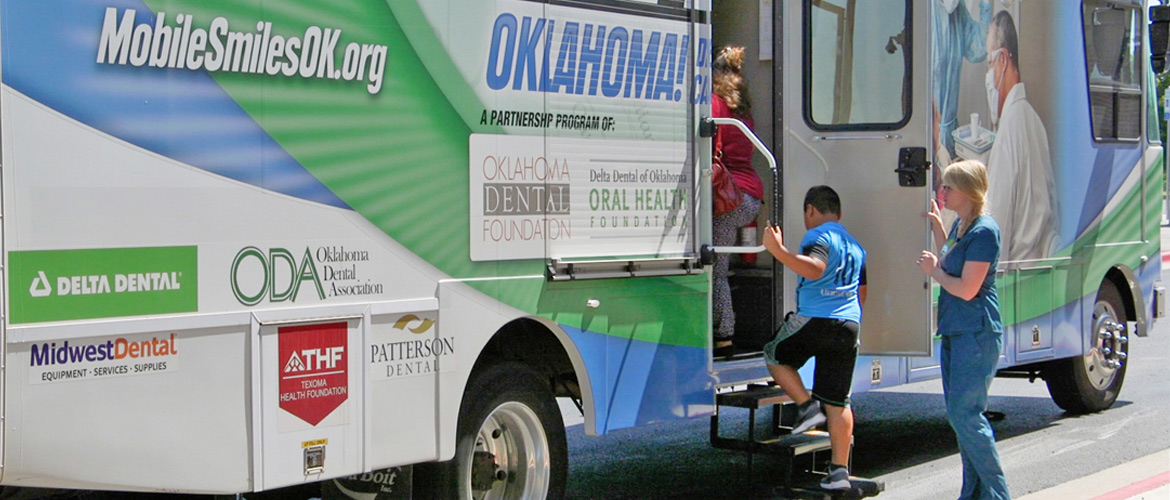The Oklahoma Dental Foundation is hitting the road to help children get the dental care that can be difficult to access statewide, especially in rural areas.
Focusing on underserved second and sixth graders, the foundation is using its fleet of five new mobile dental clinics as part of its MobileSmiles project to provide free dental services, including exams, treatments and education. The program targets communities with fewer than 6,000 residents and a lack of dental professionals — a workforce shortage plaguing almost all of Oklahoma’s 77 counties.
The goal is to provide services and education to children who probably have never had a cleaning or check-up. The students also receive toothbrushes to take home and show their families how to care for their teeth and gums.
“I feel like after getting a cleaning, the kids are going to want that again and again,” says John Wilguess, the foundation’s executive director. “If you help them take care of their teeth, you can really have an impact on their health care.”
A $50,000 Blue Impact℠ grant from Blue Cross and Blue Shield of Oklahoma is providing 20 days of oral health treatment and dental education. Treating about a dozen patients each day, a team of dental professionals works with local health departments and schools to ensure students most in need of care receive it.
“We need to help make it where going to the dentist’s office becomes a natural part of life,” Wilguess says. “Even though SoonerCare (Oklahoma’s Medicaid program) covers kids’ dental services, they still don’t go. The education piece about the importance of oral health is critical.”
Although linked to chronic diseases such as diabetes and cardiovascular disease, poor oral health care pervades Oklahoma’s population. Cost prevents many people from seeking care, and low-income older adults are more likely to lose teeth, according to research published in Frontiers in Oral Health.
In 2023, most of the 1,300 adults served by the dental foundation’s mobile clinics earned less than $20,000. They received more than $600,000 in care.
“There are so many people with dental pain,” Wilguess says. “We want to try to make sure Oklahomans are healthier.”
Meantime, the state’s most recent oral needs assessment of third graders revealed 67% of students have treated and untreated tooth decay. That means each third-grade child averages three teeth that are decayed or treated for decay.
“Dental care is expensive and difficult to access, especially for those working hourly-shift jobs and unable to take off work,” Wilguess says. “Unless there’s a problem, you don’t go to the dentist.”
MobileSmiles patients on average require eight procedures, demonstrating the significant need for services.
With the Blue Impact grant program, BCBSOK awarded 22 Oklahoma nonprofits more than $993,000 in 2024. The program invests in organizations working to address social and economic drivers of health, including locally defined health solutions.
“We are happy to support access to oral health care in rural areas of our state through this Blue Impact grant to the Oklahoma Dental Foundation,” says Brooke Townsend, BCBSOK community affairs director. “We understand the direct impact good dental health has on overall health and it is Blue Cross and Blue Shield of Oklahoma’s goal to make quality care accessible in all 77 counties. This investment is critical to serving Oklahomans in need.”
Overcoming barriers to care
Twenty years ago, the foundation started its free and low-cost MobileSmiles program with two custom fifth-wheel trailers to help make oral health care more accessible. It recently bought five new mobile dental clinics after receiving $5.1 million in state funding to reach more Oklahomans in need of care.
Four dental clinics are stationed in the state’s quadrants, and the fifth travels between Oklahoma City and Tulsa. Volunteers and University of Oklahoma School of Dentistry students staff the clinics, providing services, including exams, X-rays, cleanings, fillings, extractions and sealants.
Wilguess routinely meets Oklahomans whose circumstances have led to multiple extractions, and he has seen how the procedure can alleviate pain, yet severely damage self-esteem and limit opportunities because of tooth-loss stigma. He wants early intervention to eliminate extraction as a treatment option.
“We need to intersect with people living their daily lives by being in the places where they are and bringing services to them,” Wilguess says.

